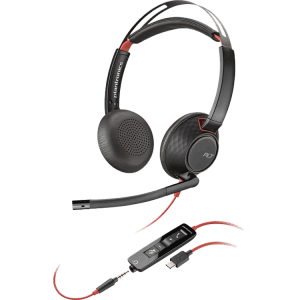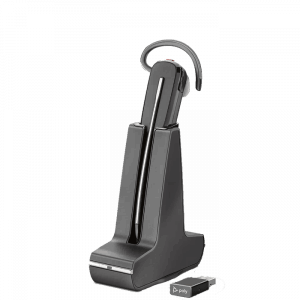Headsets 101: Ultimate Guide to Understanding Headsets
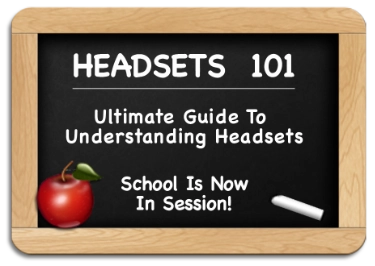 Headsets have become commonplace in our new iWorld of technology. With so many choices, applications, plug-ins, adapters and options…where do you begin?
Headsets have become commonplace in our new iWorld of technology. With so many choices, applications, plug-ins, adapters and options…where do you begin?
Our HEADSETS 101 Guide will explain headsets in detail with numerous pictures to help you visualize which devices and cables you need, where and how they connect, along with anything else you need for the perfect headset solution. We will be updating the guide often as technology changes in our complex world of headsets for your office, home, mobile, and computer.
Last Updated – May 2023
What Makes Headsets Direct Your Best Choice?
• Headset / IT specialists since 1996
• Authorized Dealers (Unlike 3rd party sellers on Amazon, eBay, etc.)
• Guaranteed genuine product with full warranty and support
• Real people to simplify solutions, verify compatibility and meet delivery deadlines
• A+ rating with the Better Business Bureau
Click on the choice below which best describes your headset need:
1) Office Corded Headsets
1 – Where Do Corded Headsets Plug Into?
With hundreds of telephones available on the market, you will find three typical methods used to plug a headset into a telephone:
1) Many older phones and more basic phones will require an amplifier that plugs into the handset port on your telephone.
2) Many newer phones have a modular headset port usually located on the bottom of your telephone to plug into.
3) A few manufacturers have opted for a 2.5mm headset jack on the side of your telephone to plug a headset into.
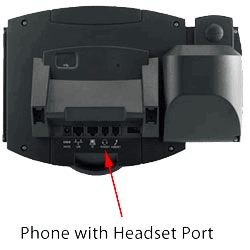
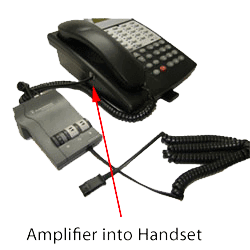
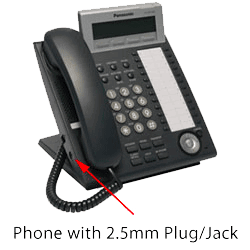
2 – What’s Required?
To have a corded commercial grade headset solution you will need two items; the headset and either an amplifier or a quick-disconnect (bottom) cable.
Quick Disconnect
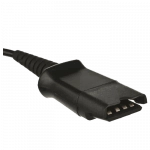 The first thing to understand about commercial grade headsets is that the headset cable ends in what the industry calls a “quick-disconnect” connection. This connection allows you to leave your headset on at all times and quickly disconnect from the amplifier, or bottom cable, when you need to walk away from your desk. (Low end consumer grade headsets don’t have a quick disconnect, and you have to remove your headset every time you want to leave your desk.)
The first thing to understand about commercial grade headsets is that the headset cable ends in what the industry calls a “quick-disconnect” connection. This connection allows you to leave your headset on at all times and quickly disconnect from the amplifier, or bottom cable, when you need to walk away from your desk. (Low end consumer grade headsets don’t have a quick disconnect, and you have to remove your headset every time you want to leave your desk.)
A quick disconnect is unique to each headset manufacturer so you can’t mix and match between brands. A quick disconnect is made to be pulled apart and re-connected an endless amount of times without ever wearing out.
Amplifiers and Direct Connect Cables
Many first time commercial grade headset users assume you only need to purchase a headset, not understanding amplifiers and bottom cables. As you can see by the picture, buying only a headset will result in immediate frustration because your headset will not have anything to plug into. To connect your headset to your telephone, you also need an amplifier or bottom cable, depending on your phone. Plantronics’ amplifiers are compatible with most single-line and multi-line phones, and are the most commonly used devices. They provide a mute switch, speaker and microphone volume adjustment, and give the highest possible call quality available.
To Help with Compatibility – We have put together the following quick reference guides for the most popular phones:
- Avaya Telephone Users
- Cisco Telephone Users
- Grandstream Telephone Users
- NEC Telephone Users
- Nortel Telephone Users
- Panasonic Telephone Users
- Polycom Telephone Users
- ShoreTel Telephone Users
- Snom Telephone Users
- Toshiba Telephone Users
- Yealink Telephone Users
3 – Amplifiers
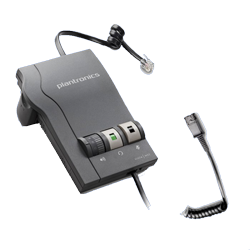 An amplifier (Plantronics M22 pictured) is a piece of equipment that sits between the headset and the phone. The amplifier plugs into the phone jack where your telephone handset (receiver) currently plugs in. Your handset then plugs into the amplifier so when the amplifier is on, your headset is active. When the amplifier is off, your handset (receiver) is active.
An amplifier (Plantronics M22 pictured) is a piece of equipment that sits between the headset and the phone. The amplifier plugs into the phone jack where your telephone handset (receiver) currently plugs in. Your handset then plugs into the amplifier so when the amplifier is on, your headset is active. When the amplifier is off, your handset (receiver) is active.
On older phones you will need to remove your handset and set the handset to the side of your phone to establish a call. When finished, you will need to replace your handset to hang up the call. This is because you need to raise and lower the switchhook lever located under your handset ear piece to get a dial tone and hang up calls. Is this a nuisance…yes…but it’s what makes headsets universal with most phones. Changing to a different amplifier or manufacturer will not change the fact that you need to raise and lower your handset for each call.
Newer phones will have a headset port to plug into and a “Headset” button (or “speaker” button) which allows for on-hook dialing so you don’t have to remove your telephone handset for each call. You simply press the “Headset” button (or the “speaker” button) or the ringing line button to answer a call and press the “Headset” button to hang up a call.
Amplifiers have speaker volume and microphone volume, compatibility settings for your specific phone, and a mute button. AA batteries are included to power the amplifier. Batteries typically last six months to two years, depending on use, and will beep in your ear during calls when the batteries are low. When the batteries are low, you will have weeks to change them, so there’s no fear of disconnecting a call. You can also purchase an optional A/C adapter to eliminate the need to purchase batteries. Finally, an amplifier will come with two cords. One, called a “pig tail”, connects the amplifier to your phone, and the other is a coiled cord that connects the amplifier to your headset using the quick disconnect connection.
-
$76.60
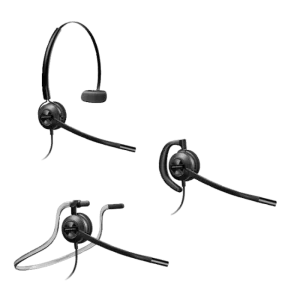 Poly EncorePro HW540 Headset(Quick Disconnect)Add to cart
Poly EncorePro HW540 Headset(Quick Disconnect)Add to cart
-
$91.44
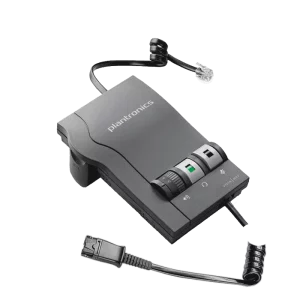 Poly M22 Vista AmplifierAdd to cart
Poly M22 Vista AmplifierAdd to cart
4 – Direct Connect Cable
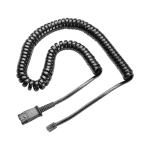 Many newer phones allow the use of a Direct Connect cable (A10 pictured) to plug into a headset port. This is a less expensive solution ($30-40) than an amplifier ($90-100), but it also limits your volume and sound quality. With a Direct Connect cable, you are relying on your telephone to provide adequate speaker and microphone volume. Approximately 60-75% of the time a Direct Connect cable will work satisfactorily, where an amplifier will be satisfactory 100% of the time, because an amplifier has microphone and speaker controls. It is imperative that you check a compatibility guide or consult a headset expert to determine if a Direct Connect Cable is an option and which one would be best. There are currently 15-20 different cables with different wiring and volume levels.
Many newer phones allow the use of a Direct Connect cable (A10 pictured) to plug into a headset port. This is a less expensive solution ($30-40) than an amplifier ($90-100), but it also limits your volume and sound quality. With a Direct Connect cable, you are relying on your telephone to provide adequate speaker and microphone volume. Approximately 60-75% of the time a Direct Connect cable will work satisfactorily, where an amplifier will be satisfactory 100% of the time, because an amplifier has microphone and speaker controls. It is imperative that you check a compatibility guide or consult a headset expert to determine if a Direct Connect Cable is an option and which one would be best. There are currently 15-20 different cables with different wiring and volume levels.
What you need:
1) A compatible Direct Connect Cable
2) Any Poly QD-Series Headset
5 – Modular Plugs
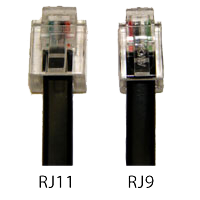 Headsets don’t plug directly into your telephone. A Headset Amplifier or Direct Connect Cable is required, which plugs into your telephone using a hard plastic, modular connector called an RJ9 headset jack (which is equal to and also called RJ22 headset jack). This jack or modular plug can be clear or smoke colored. The handset/headset RJ9 jack is smaller than the RJ11 telephone jack you will find on your wall at home, and the signals carried on the wires are completely different, so cutting one connector off and replacing with the other is pointless. RJ9 wires carry audio, so you can talk and listen to callers. RJ11 carries higher voltage, tip, and ring, so your phone rings when a signal is received, you get a dial tone so you can initiate calls, and you get audio so you can hear the caller.
Headsets don’t plug directly into your telephone. A Headset Amplifier or Direct Connect Cable is required, which plugs into your telephone using a hard plastic, modular connector called an RJ9 headset jack (which is equal to and also called RJ22 headset jack). This jack or modular plug can be clear or smoke colored. The handset/headset RJ9 jack is smaller than the RJ11 telephone jack you will find on your wall at home, and the signals carried on the wires are completely different, so cutting one connector off and replacing with the other is pointless. RJ9 wires carry audio, so you can talk and listen to callers. RJ11 carries higher voltage, tip, and ring, so your phone rings when a signal is received, you get a dial tone so you can initiate calls, and you get audio so you can hear the caller.
In Summary:
RJ9 headset plug = 4P4C which means 4 position, 4 conductor used to plug into headset and handset ports
RJ22 headset plug = 4P4C which means 4 position, 4 conductor used to plug into headset and handset ports
RJ11 headset plug = 6P4C which means 6 position, 4 conductor used for telephones and modems
RJ45 plug = 8P8C which means 8 position, 8 conductor used for computer networking
6 – 2.5mm Headset Jack
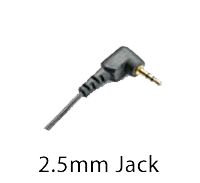 A few telephone manufacturers have opted for a 2.5mm jack for headset use. Unfortunately, this is both good and bad. It’s good because your telephone will have a “Headset” button you can press to answer and hang up calls without needing to lift your handset for each call. The bad is that some business users will make the mistake of purchasing a home-use quality headset with a 2.5 mm plug for use in their office environment. The quality is poor, choices are limited, and the cord is so short you’ll find yourself hovering over your telephone making the headset practically useless. A commercial grade headset can still be used when your phone has a 2.5 mm jack and is the preferred solution for quality. You have two options:
A few telephone manufacturers have opted for a 2.5mm jack for headset use. Unfortunately, this is both good and bad. It’s good because your telephone will have a “Headset” button you can press to answer and hang up calls without needing to lift your handset for each call. The bad is that some business users will make the mistake of purchasing a home-use quality headset with a 2.5 mm plug for use in their office environment. The quality is poor, choices are limited, and the cord is so short you’ll find yourself hovering over your telephone making the headset practically useless. A commercial grade headset can still be used when your phone has a 2.5 mm jack and is the preferred solution for quality. You have two options:
Option 1 – Use an amplifier for complete volume control (preferred method).
-
$76.60
 Poly EncorePro HW540 Headset(Quick Disconnect)Add to cart
Poly EncorePro HW540 Headset(Quick Disconnect)Add to cart
-
$91.44
 Poly M22 Vista AmplifierAdd to cart
Poly M22 Vista AmplifierAdd to cart
-
$16.65
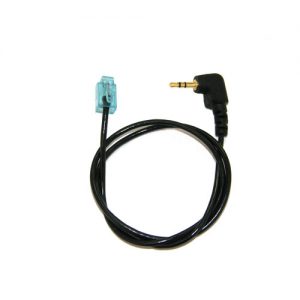 Poly 2.5mm Adapter PlugAdd to cart
Poly 2.5mm Adapter PlugAdd to cart
Option 2 – Alternative method using a patch cable with no volume control.
-
$76.60
 Poly EncorePro HW540 Headset(Quick Disconnect)Add to cart
Poly EncorePro HW540 Headset(Quick Disconnect)Add to cart
-
$14.52
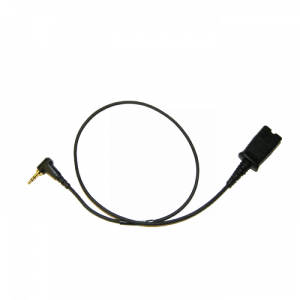 Poly 2.5mm QD Cable for H-Series HeadsetsAdd to cart
Poly 2.5mm QD Cable for H-Series HeadsetsAdd to cart
7 – Headsets – Noise-Canceling vs. Voice-Tube
When it comes to selecting a headset, your environment and personal wearing style are the two factors to consider. If you’re working in a loud environment or have more than a few co-workers in a small area causing a significant amount of background noise, you will need a Noise-Canceling headset. The microphone on a Noise-Canceling headset makes your voice clearer to your caller. A Noise-Canceling headset has no benefit to you and doesn’t let you hear better in a loud environment; it only helps your caller. A Noise-Canceling headset has a microphone boom, and the actual microphone electronics are located at the end of the boom. The front side of the microphone targets your voice, and the back side of the microphone picks up and dampens any background noise. The headset focuses on emphasizing your voice and reducing the background noise.
It is important to know that standard Noise-Canceling headsets will reduce your background noise by up to 75%, but it will not remove the background noise completely. Many headset users working from home are hoping if they purchase a Noise-Canceling headset it will hide the dog barking or baby crying in the background. Sorry, that’s not the case with most headsets.
Newer high-end headsets are starting to have the engineering to remove the dogs barking and babies crying. This technology also work well in loud call centers with hundreds of users all in close proximity. Poly’s Acoustic Fence uses multiple microphones so you can peacefully talk to your callers and they will have no idea of the chaos of your background. Truly amazing!
If you’re in a quieter environment, a Voice-Tube headset will work better, giving your caller the most crisp, clear audio quality available. Most headsets come in both Noise-Canceling and Voice-Tube models, so you can base your purchase decision on your environment without compromising on style. If you’re unsure about your background noise, a simple test is to call into the environment where you plan to use the headset and have the person on the other end be silent while you listen for noise and conversations in the background. If you hear background noise, you need Noise-Canceling…if not, save a few dollars with the Voice-Tube headset which will also sound better in the quieter environment.
Always position your microphone approximately 1/4 of an inch away from the edge of your mouth for best results. If you are using a voice-tube model, Plantronics recommends replacing your voice-tube every six months to ensure the best possible sound quality to your callers. This is a good rule of thumb, but it really depends on how well you take care of your headset. At the end of a voice tube is a very fine, wire screen that keeps the tube clear from obstruction. If you eat while wearing your headset, small food particles will always find their way to the end of the tube, covering the screen and reducing your voice volume. Similarly, if you wear makeup, it can clog the screen. In these scenarios, you may need to replace the voice tube more often than every six months. If you don’t eat or wear makeup with your headset on your voice-tube can last forever, because it’s made of plastic and there are no electronic components to go bad. From experience, cleaning rarely works and usually only packs the obstruction further into the screen, which reduces your voice more.
8 – Headsets – Over-the-Head vs. Over-the-Ear
When choosing how you want the headset to fit, your personal preference is key, but your environment will also play a part in the decision. If you’re in a louder environment an Over-the-Head headset will perform better because the full sized ear cushion against your ear helps block out noise around you from what you’re hearing in the headset. In extremely loud environments, covering up both ears is best. Also consider how you interact with co-workers. If you need to talk, interact, and hear what’s going on in your office, a single-ear (monaural) or over-the-ear headset is best, leaving one ear open. If you need to completely focus on your caller, covering up both ears (binaural) is optimal to block out noise around you. Over-the-Ear headsets are much smaller, lighter weight and more discrete than Over-the-Head headsets. This is where your personal preference will ultimately decide which headset to choose.
Left Ear or Right Ear
Headsets are not ear specific and you can easily switch the headset to fit either ear. Binaural (both ears covered) headsets can be worn with the microphone on either ear.
Convertible Headsets
If you’re still undecided or new to headsets, you may want to consider a convertible headset. A convertible headset comes with multiple wearing styles and allows you to find that perfect fit. A convertible headset is also beneficial in an office where people share headsets with different wearing preferences, because you can quickly and easily change to the style you prefer for your shift.
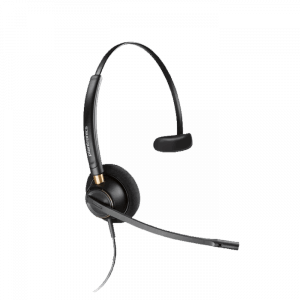 |
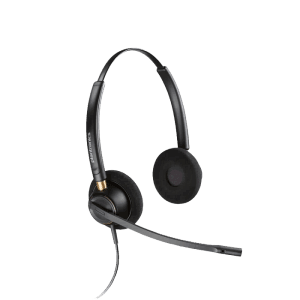 |
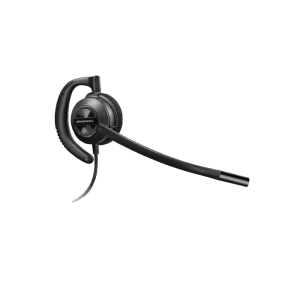 |
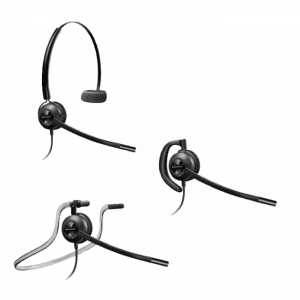 |
| Over-the-Head (Monaural) | Over-the-Head (Binaural) | Over-the-Ear | Convertible (Multiple options) |
9 – Headset Accessories
With corded headsets, there are a few headset accessories that will make your life easier. First are leatherette ear cushions which slide over your hair, making your headset slide on and off faster without getting tangled in your hair; the standard foam cushions have a tendency to tangle with longer hair.
Next is a Y-cord for training. When you hire new staff or simply want to monitor existing staff for coaching, the Y-cord lets you listen into calls and take over calls when needed. Last is a 10ft extension cord for when you need a little more reach and you’re not ready to jump to wireless.
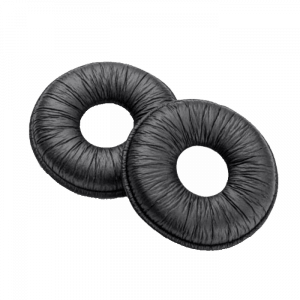
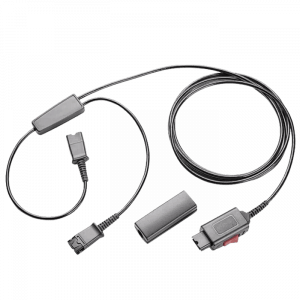
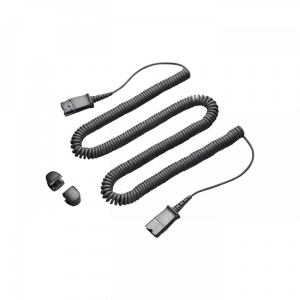
2) Office Wireless Headsets
1 – Where Do Wireless Headsets Plug Into?
When considering wireless headsets, you will find two typical ports on your telephone to plug a wireless headset into:
1) The most common is to plug the wireless base/charger into your telephones handset port.
2) Many newer phones have a modular headset port, usually located on the bottom of your telephone, to plug the base into.
Plug into Handset
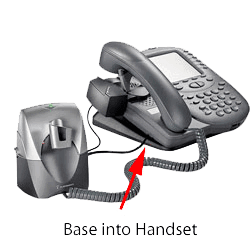 On most telephones, you will plug into your handset port. To operate, you first push the button on the side of the headset, known as the Call Control Button to turn the headset on. Next, you will lift your handset and set it to the side of your phone. This will either connect you to your caller or provide a dial tone to then start dialing on your telephone. Once a call is established you have the freedom to roam your office while you talk. When finished with the call, place your handset back in the cradle to hang up your call and push the Call Control Button to turn your headset off. Some users prefer to leave the headset on at all times to simplify the procedure, but make sure your battery time is sufficient for having the headset on at all times. See #2 and #3 for remote Answer and Hang Up information.
On most telephones, you will plug into your handset port. To operate, you first push the button on the side of the headset, known as the Call Control Button to turn the headset on. Next, you will lift your handset and set it to the side of your phone. This will either connect you to your caller or provide a dial tone to then start dialing on your telephone. Once a call is established you have the freedom to roam your office while you talk. When finished with the call, place your handset back in the cradle to hang up your call and push the Call Control Button to turn your headset off. Some users prefer to leave the headset on at all times to simplify the procedure, but make sure your battery time is sufficient for having the headset on at all times. See #2 and #3 for remote Answer and Hang Up information.
Plug into Headset Port
 If you have a telephone with a headset port, you will push the button on the side of the headset, known as the call control button, to turn the headset on. Next, press the ringing line for an incoming call or press an available line to make an outbound call and begin dialing. Once a call is established you have the freedom to roam your office while you talk. When finished with the call, press the Headset Button on your telephone to release the call and push the Call Control Button to turn your headset off. Some users prefer to leave the headset on at all times to simplify the procedure, but make sure your battery time is sufficient for having the headset on at all times. An important concept to understand is if you are plugging into the headset port, you will not be able to answer or hang up remotely. See #2 and #3 for remote Answer and Hang Up information.
If you have a telephone with a headset port, you will push the button on the side of the headset, known as the call control button, to turn the headset on. Next, press the ringing line for an incoming call or press an available line to make an outbound call and begin dialing. Once a call is established you have the freedom to roam your office while you talk. When finished with the call, press the Headset Button on your telephone to release the call and push the Call Control Button to turn your headset off. Some users prefer to leave the headset on at all times to simplify the procedure, but make sure your battery time is sufficient for having the headset on at all times. An important concept to understand is if you are plugging into the headset port, you will not be able to answer or hang up remotely. See #2 and #3 for remote Answer and Hang Up information.
2 – What’s Required?
A commercial grade wireless headset solution is purchased as a complete system (Base/Charger, Headset, A/C Power Adapter are included). Optionally a Handset Lifter or Electronic Hookswitch Cable (EHS) will need to be purchased to answer and hang up calls remotely. The base/charger controls compatibility, microphone volume, speaker volume and also acts as the charger when your headset is not in use. There are LED lights on the base to indicate power, charging and other features.
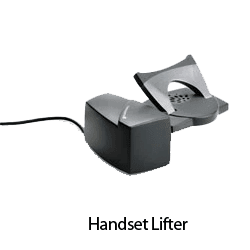
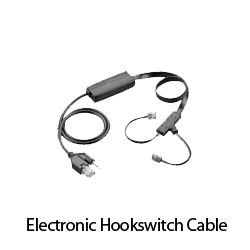
To Help with Compatibility – We have put together the following quick reference guides for the most popular phones:
- Avaya Telephone Users
- Cisco Telephone Users
- Grandstream Telephone Users
- NEC Telephone Users
- Nortel Telephone Users
- Panasonic Telephone Users
- Polycom Telephone Users
- ShoreTel Telephone Users
- Snom Telephone Users
- Toshiba Telephone Users
- Yealink Telephone Users
3 – Remote Answer and Hang-Up
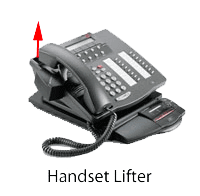 Wireless units give you freedom, and adding a Handset Lifter or EHS cable allows greater productivity by allowing you to answer and hang up remotely. Both will sense when your phone is ringing and generate beeps in your headset to alert you of a call. If you choose to take the call, simply press the Call Control Button on your headset to answer the call. Your phone answers the ringing line and you begin talking. When finished you press the Call Control Button again to disconnect the call. You will need to return to your phone to press the appropriate buttons to dial, transfer a call, or to perform any other phone functions. Most phones will support the Handset Lifter which raises and lowers your telephone’s handset, simulating you answering a call. The EHS electronically establishes calls on newer phones without the mechanical motor and physical movement of your handset, but otherwise accomplishes the same thing. Having the ability to answer remotely greatly increases your productivity. You can answer away from your desk and carry on conversations where ever you need to take them. It also allows you to answer calls that would have normally gone to voice mail. This saves you a tremendous amount of time playing phone tag with customers or co-workers.
Wireless units give you freedom, and adding a Handset Lifter or EHS cable allows greater productivity by allowing you to answer and hang up remotely. Both will sense when your phone is ringing and generate beeps in your headset to alert you of a call. If you choose to take the call, simply press the Call Control Button on your headset to answer the call. Your phone answers the ringing line and you begin talking. When finished you press the Call Control Button again to disconnect the call. You will need to return to your phone to press the appropriate buttons to dial, transfer a call, or to perform any other phone functions. Most phones will support the Handset Lifter which raises and lowers your telephone’s handset, simulating you answering a call. The EHS electronically establishes calls on newer phones without the mechanical motor and physical movement of your handset, but otherwise accomplishes the same thing. Having the ability to answer remotely greatly increases your productivity. You can answer away from your desk and carry on conversations where ever you need to take them. It also allows you to answer calls that would have normally gone to voice mail. This saves you a tremendous amount of time playing phone tag with customers or co-workers.
4 – Base/Charger
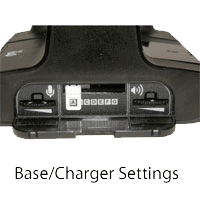 With wireless headsets the base is the brains of the unit. It has compatibility, microphone, and speaker settings. Out of the box the unit will work with most phone systems. If you do not find a speaker or microphone volume control, adjusting the compatibility dial/switch until sound is heard is the best approach. The microphone adjustment will control how loud you come across to your caller. This is typically a one-time setting because your voice doesn’t change. The speaker setting will have a major adjustment on the base. The idea is to get the setting close to perfect and then use the minor speaker adjustment on the headset for optimal volume from call to call. If you find your speaker volume is distorted or has an echo sound, adjust your telephone speaker volume down to resolve the problem.
With wireless headsets the base is the brains of the unit. It has compatibility, microphone, and speaker settings. Out of the box the unit will work with most phone systems. If you do not find a speaker or microphone volume control, adjusting the compatibility dial/switch until sound is heard is the best approach. The microphone adjustment will control how loud you come across to your caller. This is typically a one-time setting because your voice doesn’t change. The speaker setting will have a major adjustment on the base. The idea is to get the setting close to perfect and then use the minor speaker adjustment on the headset for optimal volume from call to call. If you find your speaker volume is distorted or has an echo sound, adjust your telephone speaker volume down to resolve the problem.
5 – Headset Microphone Positioning
For best results, always position your microphone approximately 1/4 of an inch away from the edge of your mouth. Almost all wireless sets have a Noise-Canceling microphone which makes your voice clearer to your caller and cuts down background noise. It has no benefit to you (except less misinterpreted info) and doesn’t let you hear better in a loud environment; it only helps your caller. A wireless headset has the actual microphone electronics at the end of the boom. The front side of the microphone targets your voice, and the back side of the microphone picks up and dampens any background noise. It is important to know that a Noise-Canceling microphone will reduce your background noise by up to 75%, but it will not remove background noise. Many new wireless headset users working from home incorrectly think using a Noise-Canceling wireless headset will hide the dog barking or baby crying in the background so no-one will know they’re working from home. Sorry, that’s not the case.
6 – Wearing Styles – Over-the-Head vs. Over-the-Ear
When choosing how you want your wireless headset to fit, your personal preference is key, but your environment will also play a part in the decision. If you’re in a louder environment an Over-the-Head wireless headset will perform better because the full sized ear cushion against your ear helps block out noise around you, helping you hear your caller better. In extremely loud environments, covering up both ears will work best. Also consider how you interact with co-workers. If you need to talk, interact, and hear what’s going on in your office, a single-ear (monaural) or over-the-ear wireless headset is best, leaving one ear open. If you need to completely focus on your caller, covering up both ears (binaural) is optimal to block out noise around you. Over-the-Ear wireless headsets are much smaller, lighter weight and more discrete than Over-the-Head wireless headsets. This is where your personal preference will ultimately decide which wireless headset to choose. Ready to see choices for the best wireless call center headsets?
Left Ear or Right Ear
Headsets are not ear specific and you can easily switch the headset to fit either ear. Binaural (both ears covered) headsets can be worn with the microphone being positioned on either ear.
Convertible Headsets
If you’re undecided or new to wireless headsets, you may want to consider a convertible model. A convertible wireless headset comes with multiple wearing styles and allows you to find that perfect fit. A convertible headset is also beneficial in an office where people share headsets with different wearing preferences, because you can quickly and easily change to the style you prefer for your shift.
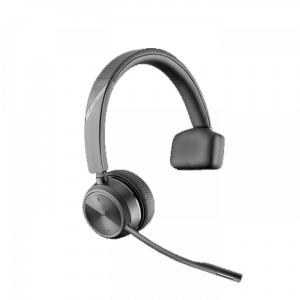 |
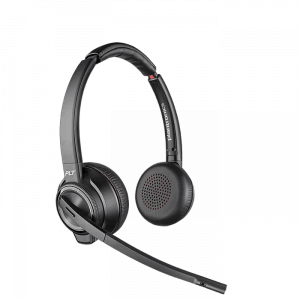 |
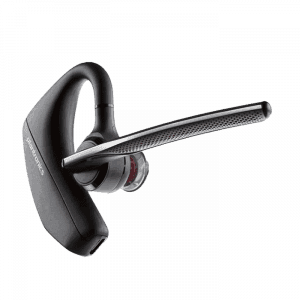 |
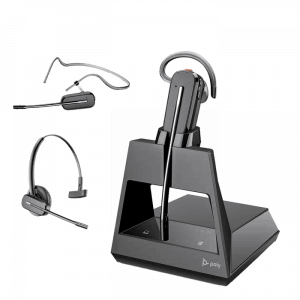 |
| Over-the-Head (Monaural) | Over-the-Head (Binaural) | Over-the-Ear | Convertible (Multiple options) |
7 – Wireless Headset Accessories
With wireless headsets, there are a few headset accessories that will make your life easier. First are the HL10 Handset Lifter or EHS Cables for remote answer/hang-up on your phone. It is a huge productivity booster to take calls remotely and not miss them to voice mail. The other wireless headset accessory to know about is the wireless training adapter. If you have new employees, you can have them listen in silently to your seasoned veterans as they learn the ropes. After training is complete you can use the wireless training adapter to listen into any staff member for continued coaching and monitoring.
 |
 |
|
3) Home Headsets
1 – What Are My Options for Home Headsets?
If you want a headset for hands-free convenience at home, you have a few options and decisions to make. One option is a telephone headset system which is a stand-alone telephone that uses a corded headset for communicating. You can also have the same setup with a wireless headset to roam your house and gain features like caller ID on the key pad. If you’re currently using cordless telephones at home you most likely have a 2.5mm jack to plug a headset into. Your last option is to consider a headset system that uses an amplifier to plug into your single-line or multi-line phone you’re currently using at home.
2 – Telephone Headset System:
The easiest option for headset use at home is to use a complete telephone headset system that functions as a stand-alone telephone. With this option, you will need an available wall jack to plug the base into. The corded system will include a base that acts as your telephone and a headset for hands-free communication. It’s like adding an additional phone to your existing house, except you use the headset for talking instead of cradling a handset against your shoulder. With the push of a button you can answer a call or have dial tone to begin dialing. The same setup is available as a wireless model which gives you the ability to roam your house and multi-task as you talk. This can be cooking, cleaning, gardening or looking up information for clients if operating your business from home. The remote unit will have standard functions for answering, dialing, and many times an LED screen to show caller ID. Most of these units will only support 1-line so if you have 2-lines, be sure to research 2-line devices knowing thought your choices will be limited.
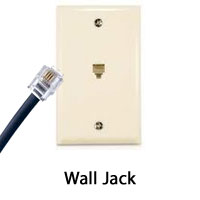 |
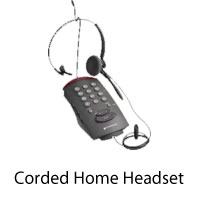 |
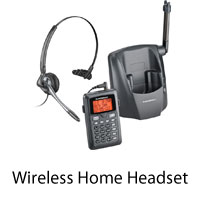 |
3 – Cordless Telephone w/ 2.5mm Headset Plug:
If you currently have cordless phones, you may want to consider adding a headset that plugs directly into you phone. It’s quick and easy and numerous choices exist. Most home cordless telephones will have a 2.5mm plug on the side of your phone for headset use. The advantage of this setup is you’re hands-free in seconds after plugging the headset in and clipping the phone to your belt (if a clip was included). The negative is most headsets with the 2.5mm plug are very low end in regards to quality and durability. You may also find your speaker volume and/or microphone volume is simply not loud enough. You also have a cordless phone to clip on your belt, if you wear one or carry with you which defeats the purpose of hands-free. It’s a solution, but with limitations.
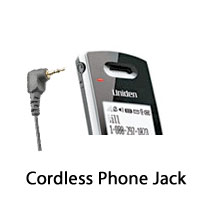 |
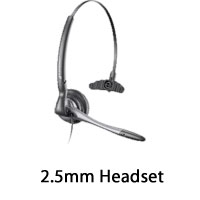 |
Many single-line up to 4-line home telephone setups are available and work well with headsets. For headsets to work on these systems, you will need a complete system compatible with multi-line phones. The base unit plugs into the phone jack where your telephone handset (receiver) currently plugs in. Your handset then plugs into the base so when the base is on, your headset is active. When the base is off, your handset (receiver) is active. On most phones you will need to remove your handset and set the handset to the side of your phone to establish a call. When finished, you will need to replace your handset to hang up the call. This is because you need to raise and lower the switchhook lever located under your handset ear piece to get a dial tone and hang up calls. Is this inconvenient …yes…but it’s what makes headsets universal with most phones. Changing to a different base or manufacturer will not change the fact that you need to raise and lower your handset for each call.
5 – How is the Quality?
The quality will be average when compared to that of commercial grade business headsets. If you’ve never used a headset and always sit at your kitchen counter while talking for hours, holding the handset against your ear, an average headset in your scope will seem like the greatest thing in the world. If you’re use to commercial grade products at the office, you will find consumer grade products having less conveniences and options. You don’t have a choice in wearing styles, you don’t have a quick disconnect to quickly walk away and if you choose wireless, you will not have the volume adjustments you’re use to. Are all of those factors going to keep you from having a headset for home? Hopefully not, as long as you keep in mind you’re spending less money for consumer grade headsets, but getting to take advantage of hands-free communication which is what headsets are all about.
4) Mobile Headsets
1 – Corded or Wireless?
As mobile/cellular phones continue to gain popularity at a staggering rate, the headset industry has equaled the pace introducing new models on a regular basis. Most mobile phones will have a 2.5mm headset jack on the side or top of the phone to quickly and easily plug a headset into. The Apple iPhone uses a 3.5mm plug to complicate headset usage but solutions are possible. Bluetooth technology took the world by storm which gives you a small, wireless headset to pair with your mobile phone. A little more complicated to use with multiple buttons for volume and call control and you will need to get in the habit of charging on a regular basis. You will also need to find how to get your phone into “pairing” mode before being able to use but once charged and paired, you get the convenience of a wireless headset without cords to tangle or tug at your ear.
2 – Corded 2.5mm Headsets.
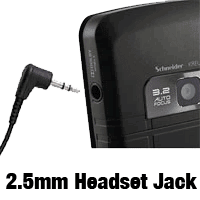 Corded headsets are the simplest to use. You simply plug them into your phone and start talking into the headset. Your phone will automatically know to use the headset when plugged in. Because these headsets are made to be portable and on the move with you and your phone, they’re light weight and less durable than commercial grade business headsets. Expect to replace them regularly as the cords get twisted, tangled and caught in doors. Also, keep in mind that the amount of speaker volume will always be dictated by your phone. Many headsets will have a volume control, but they only start at the maximum volume your phone provides and adjusts down. A headset will never amplify the volume. You will also find headset models with a mute switch built into the cord to easily mute your microphone when needed.
Corded headsets are the simplest to use. You simply plug them into your phone and start talking into the headset. Your phone will automatically know to use the headset when plugged in. Because these headsets are made to be portable and on the move with you and your phone, they’re light weight and less durable than commercial grade business headsets. Expect to replace them regularly as the cords get twisted, tangled and caught in doors. Also, keep in mind that the amount of speaker volume will always be dictated by your phone. Many headsets will have a volume control, but they only start at the maximum volume your phone provides and adjusts down. A headset will never amplify the volume. You will also find headset models with a mute switch built into the cord to easily mute your microphone when needed.
You also have the option of using a commercial grade headset and patch cord with the 2.5mm plug. This opens up the possibilities of headset choices, wearing styles and a significant upgrade in performance and durability.
What you need:
1) 2.5mm to quick-disconnect patch cable – Poly 64279-02
2) Any Poly QD-Series Headset

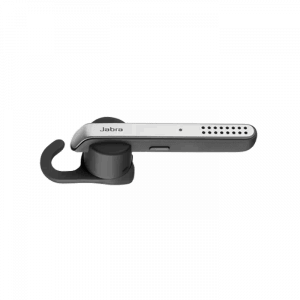
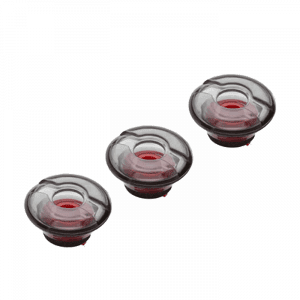
5) Computer Headsets
New to computer USB headsets? Watch our corded and wireless USB headset basics in the videos below to learn what concepts benefit you.
1 – Where Do Computer Headsets plug Into?
When using headsets on your computer or PC, you will have three very different plug-ins options available. The Universal Serial Bus or more commonly USB (technically called -A) port is the modern connector that has become the standard for all computer peripherals ranging from keyboards, mice, charging cable and headsets. The latest connection is USB-C specifically for low profile or slim laptop computers. These are typically plug-n-play and your computer will install any necessary drivers when you initially plug connect your device. The connections that have been around the longest are the Sound Board/Headset Jack connection which consists of one or two, 3.5mm jacks. One jack is for your microphone and the other is for your speaker. For cables with one jack, speaker audio will be provided and microphone will be optional. When a headset plugs into the Sound Board or Headset Jack, it takes over the sound that would normally come out your speakers. There is nothing to configure our change in the software. It’s complete hardware driven and simple to plug-in. You may have volume and mute controls built into the headset cable; however, you can control the master volume of the headset in your computer system settings.
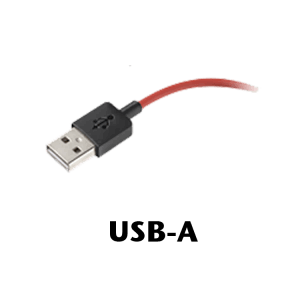
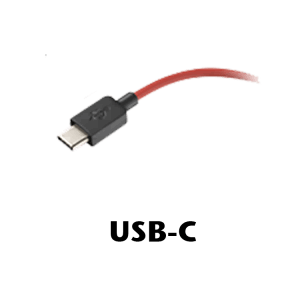
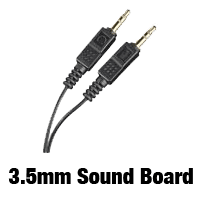

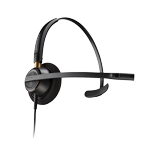
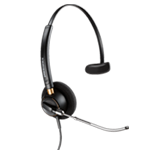
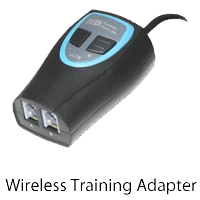
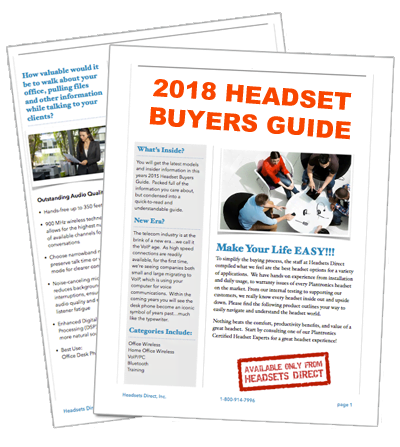
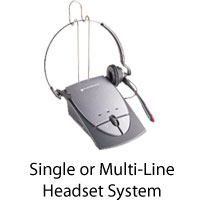
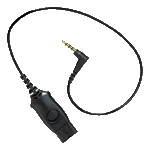 Apple & Blackberry decided to use a 3.5mm headset jack with most of their devices. Instead of limiting your choices of headsets and only making a few headsets with a 3.5mm connection, Plantronics instead made an iPhone/Blackberry cable that allows you the option of any H-Series Plantronics headset. A much better solution that gives you commercial grade headsets for your Apple & Blackberry devices.
Apple & Blackberry decided to use a 3.5mm headset jack with most of their devices. Instead of limiting your choices of headsets and only making a few headsets with a 3.5mm connection, Plantronics instead made an iPhone/Blackberry cable that allows you the option of any H-Series Plantronics headset. A much better solution that gives you commercial grade headsets for your Apple & Blackberry devices.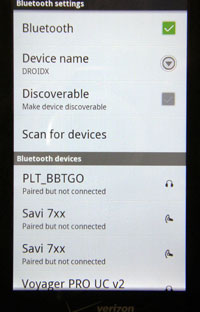 Choosing to go with a wireless headset for your mobile phone will enter you into world of Bluetooth. First to understand Bluetooth…it’s a technology standard that allows two devices to “pair” or connect and share data over a short distance usually being 33 feet. It operates in the frequency band 2400–2480 MHz and creates what’s known as a Personal Area Network (PAN). Bluetooth has become the standard for mobile phones, headsets, tablets, printers and other personal devices to share data and voice communication. When “pairing” a headset and mobile phone together you will need to locate in your phone menu choices the option to turn on Bluetooth transmission and scan for your headset. You will put the headset in “pairing” mode which sends out a signal for your phone to discover. Once found your phone will confirm you want to connect to the headset. Some phones will ask for a pass-code which is always “0000” for headsets. Your headset is now paired and ready for use.
Choosing to go with a wireless headset for your mobile phone will enter you into world of Bluetooth. First to understand Bluetooth…it’s a technology standard that allows two devices to “pair” or connect and share data over a short distance usually being 33 feet. It operates in the frequency band 2400–2480 MHz and creates what’s known as a Personal Area Network (PAN). Bluetooth has become the standard for mobile phones, headsets, tablets, printers and other personal devices to share data and voice communication. When “pairing” a headset and mobile phone together you will need to locate in your phone menu choices the option to turn on Bluetooth transmission and scan for your headset. You will put the headset in “pairing” mode which sends out a signal for your phone to discover. Once found your phone will confirm you want to connect to the headset. Some phones will ask for a pass-code which is always “0000” for headsets. Your headset is now paired and ready for use.